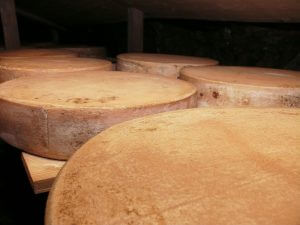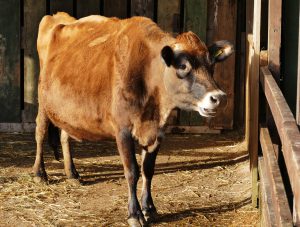
Modern pyramids in Russia (1 part)
 28. 04. 2024
28. 04. 2024




 28. 04. 2024
28. 04. 2024


 26. 04. 2024
26. 04. 2024
 1
1

 25. 04. 2024
25. 04. 2024
 18. 08. 2016
18. 08. 2016

Milk - Healthy or Killer?
Issues surrounding milk and dairy products increase its massive consumption. But we will focus the focus on milk more objectively and expand the angle of view and the spectrum of contexts.
Let us first consider the general comments and statements made in the last 50 years by the propaganda of the animal industry by dogma:
Milk contains mainly calcium (calcium), protein and a number of vitamins.
Therefore milk should be healthy.
For calcium, which is necessary to build mainly hard body tissues.
Let's take the individual components sequentially:
Yes, cow's milk contains calcium. And that's the problem.
There is so much (as well as other concentrated ingredients) that regular acid consumption of milk and dairy products breaks down. This leads not only to the reduced ability to metabolize calcium and valuable constituents, but also to the excessive excretion of vitamin D along with calcium out of the body. Vitamin D is significantly involved in bone calcium deposition.
Commercial trade means that, in the best case, zero to zero - that is, what dairy products exclude, they add, but in most cases, on the contrary, they lead to the loss of valuable substances from the organism due to:
A, Inability to digest milk protein (casein).
Therefore, it is not possible to give an equation between the calcium intake of milk and its usability by the human organism. The main problem with "milk calcium" is its absorbability.
Calcium in milk is bound to casein (milk protein), which is very difficult to use for a large part of the population because of its biochemical structure.
This is due to the fact that in adulthood, a person lacks an enzyme chymosin, which breaks down casein in newborn and toddlers. Casein, which is the major type of protein in milk, is never well digested in an adult.
Casein should not contain cheeses made from whey (eg, tricotta).
Structure and percentage of protein in cow's milk
Proteins in milk have a completely different structure than the body of well-utilized amino acids.
Protein in cow's milk is intended to provide a much faster weight gain in calves than is usual in human growth.
Therefore, by consuming (above all) cow's milk, we get into the body an abnormal amount of protein that the human organism can not effectively use.
Excessive consumption of proteins, of course, leads to a number of diseases.
Some studies state that the milk protein is unable to digest 60% of the population.
These people exert an enormous burden on their digestive tract, especially the liver, which has to break down unwashed proteins.
Milk and dairy proteins with their final balance are clearly negative.
It is necessary to realize that the propaganda of milk and its health benefits did not arise from milk research.
But on the contrary - milk has begun to be produced for economic reasons, and studies have been produced to show the importance of milk in human nutrition. Therefore, a few smart heads found synergy between the high content of some components in milk with human needs.
Unfortunately, this principle stood for millions of people believing these dogmas of health.
The lobby of the food industry is paying its truths in many places, and therefore, from the mouth of nutritionists, there is still a clutter of incredible character about the health benefits of milk (for example, from Dr. Jebavé's mouth, on The Plague on the Plate, "I would recommend milk consumption to everyone!" "Milk is a healthy food!")
Common sense drives where nonsense is taken in a college-educated "milk expert".
"For each!" This statement would be by Dr. Enough has the 200 coffin crowned millions of Europeans.
As?
B, Milk, the coffin lid, or why we lack enzymes.
Without exaggeration, milk can be talked about for another, and perhaps the most important reason.
Why?
 200 of millions of Europeans are statistically incapable (or their ability to digest them greatly reduced) to digest milk sugar (lactose), which is logically predetermined by the wise nature, which by absence lactase (enzyme digesting milk sugar)wanted to ensure a higher survival rate of the species.
200 of millions of Europeans are statistically incapable (or their ability to digest them greatly reduced) to digest milk sugar (lactose), which is logically predetermined by the wise nature, which by absence lactase (enzyme digesting milk sugar)wanted to ensure a higher survival rate of the species.
Because faster quenching from breast milk and adaptation to natural food (in the case of humans, it is predominantly plant-based) ensures a higher level of survival.
However, lactase is not the only enzyme that disappears or its rate is significantly reduced after reaching 2 years.
Chymosin is an enzyme whereby the mammalian milk in the stomach coagulates (collapses) in order to be further digested. The age of chymosin production is declining and disappearing. Therefore, in adulthood, the milk is never fully digested (in adulthood it is cleaved with pepsin by means of increased acidity of the stomach). So much biological logic of nature.
Europeans with their genealogical origin do not have sufficiently adapted mechanisms of genes coding for lactase production.
Considering that Europe is the continent with the highest consumption of milk in the world, it puts milk at the forefront of the causes of civilization diseases.
It should also be added that some nations absolutely can not spend the milk (they act directly as poison in the body - Indians tribes, Chinese, and largely Europeans).
For these nations there is a complete absence of the enzyme lactase.
What causes it in the body?
Unobtrusive timed bomb
Lack of milk sugar (absence of lactase) leads to rotting decomposition (mainly in the large intestine), which involves bacteria that cause dominant disbalance of otherwise balanced microflora.
Similarly, non-destruction of casein occurs.
Fermented milk (yoghurt, cheese, etc.) should have an enzyme-altered structure of milk sugar, so that this mechanism is in part supplemented by the usual absence or low proportion of secreted lactase in an adult human.
However, in conventional commercial operations, fermentation processes do not proceed in a proper manner, so that the acid products contain lactose, which ultimately contributes to the development of various civilization diseases.
Lactose should not contain long-lasting hard cheeses.
Raw or pasteurized?
Supporters of healthy nutrition are of the opinion that it is better to drink raw milk - they retain all the substances in their original state.
Thus they are not degraded by heat treatment.
Is it necessary to pasteurize or otherwise heat the milk?
The answer is a bit foolish - yes, under the circumstances it is necessary.
It is necessary, however, due to the way of breeding, fattening of cattle, sickness of farmed cattle in large-scale livestock. Thanks to the possibility of transferring diseases from cow's raw milk to humans (E. coli, tuberculosis, mastitis, encephalitis and others), milk pasteurization is required.
The truth is, however, that the massive expansion of pasteurization did not lead to the risk of disease transmission (this is minimal in cows kept in the clean conditions of farms with a low number of cows).
The risk of transmission increases the concentration of cattle in one place, the use of antibiotics and hormones, absolutely inappropriate feeding (cereal scrap, GMO soy, instead of natural grass). This leads to poor cattle health and increases the risk of transmission of pathogens to milk.
But the truth is even more sad - pasteurization is needed in particular by traders who can store milk for a long time (pasteurization due to the destruction of the vital substances, it dips the fluid and prolongs the time from which the milk will start to deteriorate due to the microorganisms).
The same reason as white flour production.
History of milk
Cow's milk has been used sporadically for roughly 6500 flights in the fertile half-moon (from Egypt to India).
At this time, local farmers began to domesticate the original types of tour (the analogy of today's cows).
The milk was drunk fresh and only when the cow was in the lactation cycle (after the birth of the calf).
That is, it could never happen that the person at that time would have "milk on the table" every day.
The penetration of livestock breeding has not changed any milestones in the history of mankind, such as the beginning of the Industrial Revolution, and especially the Poles after the Second World War.
Extension of cows' milk consumption occurred in 50. years of the twentieth century. With this, his artificially created propaganda gradually increased consumption for the sole reason of increasing production.
Obviously very important information for our territory is the simple fact that the Neolithic Revolution, which has expanded livestock breeding and thus left milk consumption and still leaves enormous scars on the health of people who are not genetically adapted to it.
Europeans have their genealogical origin different from those who have gradually recovered their cow's milk in the fertile crescent territory.
Other risks:
Milk contains a number of substances added to feed mixtures of bovine animals.
They are mainly growth hormones (in the Czech Republic their consumption by cattle is prohibited). However, their production is steadily increasing - so the question is: “what they are used for and who is expensive  buying? "
buying? "
Next as well as broad-spectrum antibiotics (in the Czech Republic, they are administered under veterinary supervision and there is a distance from which dairy cows should not be taken after the administration of antibiotics). Although antibiotics in the milk may not be present in accordance with applicable laws, they affect the health of cows. And much more significantly than people do. The digestive system of the bovine is completely dependent on the presence of microorganisms that allow the digestion and use of food. Antibiotics directly act against these natural symbiotic microorganisms. If this equilibrium is disturbed, the whole metabolism of dairy cows is disturbed.
Stress
The level of stress hormones and the overall health of cows in milking is directly reflected in the quality of the milk.
Other crucial information that consumers have somehow stopped becoming aware of is how milk is gaining.
From the cow, the milk automatically does not flow just like that.
Just because we want it. So not naturally.
But in fact, yes - cows are artificially inseminated and maintained by artificial milking to milk when we want.
Diet and breeding conditions
Not only do the animals not naturally live a healthy environment and force them to unnatural mechanisms (housing, number of cattle per square meter, lack of fresh air, sun, grass). But we also adapted cattle diet to economic factors.
Genetically modified soy and maize, hybridized wheat in granulate. This is an important element in feeding livestock. And equally important in terms of influencing the quality of milk (or meat). GMO is at least controversial, if not dangerous in many ways.
The concentration of large numbers of livestock in enclosed areas increases the rate of transmission of infectious diseases and has a very adverse effect on cattle health.
Not all of this is natural.
It is paradoxical that these twisted mechanisms are based on a product that some still claim to be beneficial to humans..
Milk Statistics:
World milk production today exceeds 500 million tons per year.
The largest is in Europe - 210 million tons. North America follows - almost 79 million tons, India, where it is produced annually via 70 million tons, South America 43 million.
Low production is in Japan, which gives preference to coconut milk before the animal, and in China. The literal scarcity is on the African continent - just 2 million 300 thousand tons a year.
The world's most consumed cow's milk.
It represents 85,26% of world milk consumption. This is followed by milk buffalo (10,76%), goat (2,24%), sheep (1,5%) and camel (0,23%). Average per capita consumption is a glass of milk a day, but there are large differences between countries. In tropical countries, milk is consumed considerably less while residents of North America and Nordic European countries consume it most. The largest amount of milk, up to two liters a day, drinks Finns, Danes, Norwegians, but also New Zealanders. In Ireland, the average milk consumption per person per year is 163 liters, in the UK 117 and in the Netherlands 101 liter per capita per year. France, Germany and Italy are around 65 liters. In India they are 33 liters and in Japan 39 liters. In China, on average, only two liters of milk is consumed per person per year
Statistics that completely reproduce milk consumption are statistics on the occurrence of osteoporosis.
Osteoporosis is a simplified bone thinning due to calcium depletion in bones.
It is a serious illness that demobilizes more and more people at a later age.
It is still the disease that recommends higher consumption of dairy products.
The statistics of the country with the largest consumption of milk and dairy products are absurd.
The countries that most consume milk (USA, Finland, Denmark, Great Britain) are the same countries with the highest incidence of osteoporosis.
résumé:
 So we're back in the beginning. Again, common sense and intelligence.
So we're back in the beginning. Again, common sense and intelligence.
Some arguments of biology:
Tele, which is physiologically capable of digesting cow's (ie breast milk) has 4 stomach, resp. 2 prehistory, the first of which immediately participates in fermentation of food. However, in the first phase of life of the calf, milk passes directly into the stomach (it passes the unprepared pre-chal- lenges through the stomach cavity into the saliva - the equivalent of the stomach).
However, one is physiologically completely constructed. Neither the externalized fermentation process of dairy products will ensure a perfect digestion of milk sugar.
Milk (especially cow's, indifferent, whether heat-treated or not) as such is NOT intended for human nutrition.
So how to answer the question of drinking or not drinking milk?
If you are a calf, drink it.
The human organism is also able to use very inappropriate food for its survival.
However, milk is not a food that one should consume for a long time.
Especially not cow's and certainly not in pasteurized state from bovine cattle.
Milk in the history of mankind certainly plays a key role as a substitute foodstuff to ensure survival in times when it was difficult and impossible to store other foods for a long time in a period of growing decline. However, today, when we can afford fresh food - vegetables, fruits at any time of the year, it does not apply. In addition, we have expanded other food storage options such as freezing, drying, sterilization, which make it possible for the biologically appropriate (plant) diet to perfectly balance the intake of necessary nutrients when the leaves are not trees and the soil is hardened by frost.
Practical solutions:
The usual problem with milk consumption is a human habit.
We use milk not only for drinking.
Hidden milk is in many other foods.
We use it for cooking, baking to produce many other dishes - bakery products that combine with white flour from hybridized wheat makes it really dangerous for our digestive system.
Many people nowadays long for simple solutions.
I get questions like: "What should I do if I do not want milk to drink?"
Or absolutely crucial: "What should I replace for milk? "
The answers are obvious: from the nutritional point of view, there will be no significant decrease in the body of usable substances when not consuming milk.
On the contrary, the negative effects associated with its consumption will be significantly reduced.
A diet based on organically-suited crops (vegetables, fruits, nuts, seeds, sprouts) is fully able to provide the benefits of many more beneficial substances that are recommended for milk consumption (calcium, vitamin D).
From the point of view of habit - Thus, the use of milk in the kitchen is a practical and effective solution.
For many, it has become a natural part of so- vegetable milk
These can be purchased at any hypermarket (sometimes expensive - I recommend shopping over the internet), eg milk in BIO quality soybeans from Austrian producer Kaufland 1 liter - 40, -Kč. For complete comfort, however, it is possible to buy a home-made vegetable milk plant, where you can prepare nutritionally rich herbal milk from cannabis, soybean, rice (really interesting is milk from black rice, pitcher, almonds.
When baking, when milk as well as eggs are used as a binder of dough, can be very well supplemented, for example, with crushed flaxseeds mixed with water, crushed bananas can be used for sweet bread.